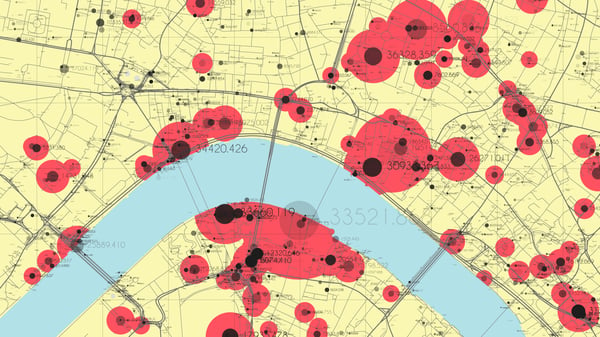4 Must-have Data Points for Dispatch-Billing Alignment and Maximum Reimbursement
The National EMS Assessment: Ten Years Later
2020 NASEMSO Survey Reflects Evolution of EMS Industry
Was this information valuable?

2020 NASEMSO Survey Reflects Evolution of EMS Industry
(7 min read) In 2011, the first comprehensive National EMS Assessment was completed, thanks to funding by the National Highway Safety Administration (NHTSA) and the leadership of the National Association of State EMS Officials (NASEMSO) and multiple other organizations. Recently NASEMSO released an updated 2020 version of the National EMS Assessment.

Having led the 2011 EMS Assessment data collection process, I’ll share through this blog a high-level summary of the changes that have occurred within EMS and our industry over the past 10 years. The original 2011 goal of the EMS Assessment was to describe EMS from a “System of Care” perspective. Data were collected (interestingly, using iPads) via an extensive survey and compiled from all 56 states, territories, and the District of Columbia. The 2020 EMS Assessment was administered in the same spirit, and 54 of the 56 geographies participated. Since both assessments were completed by survey, not every state and territory was able to complete every question. That being said, there are four main topic areas we can consider.
EMS Agencies
EMS Agencies are typically classified as closely as possible to the NEMSIS definition. The five main groups are: 911 Response to the Scene With Transport, 911 Response to the Scene Without Transport, Ground Specialty Transport Services, Air Medical Services, and Emergency Medical Dispatch (EMD) Centers.
Overall, the number of EMS Agencies grew from 19,971 in 2011 to 23,272 in 2020. This was an increase of 16.5% over the 10 years or 1.6% average annual growth.
General trends observed comparing the 2011 with the new 2020 EMS Assessment include:
- The largest change of any EMS Agency Type was noted with Ground Specialty Care Services, with an increase from 411 in 2011 to 1,988 in 2020. (383.7% total growth or 38.3% average annual growth). This change may represent an increased need for a higher level of care associated with time-dependent illness and injury, such as STEMI, stroke, cardiac arrest, and trauma. Another possible contributing factor to this growth could be an increase in interfacility resources to assist local EMS agencies that are challenged to provide interfacility transport service while maintaining their local community service responsibilities.
- The only EMS Agency Type that that contracted was 911 Response to the Scene With Transport, which decreased from 12,575 in 2011 to 11,450 in 2020. This represents a total decrease of -9.0% or -0.9% average annual decrease. The change may represent some level of industry consolidation or a shift toward Specialty Care and Air Medical Agencies.
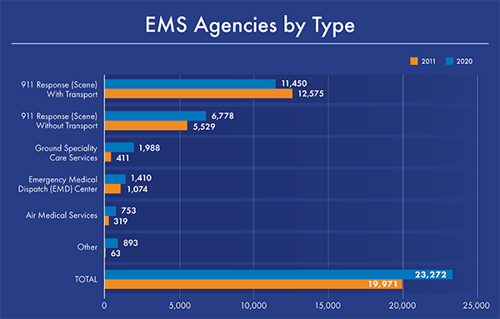
EMS Vehicles
EMS Vehicle Types and Numbers are also mapped to the NEMSIS definition. The four main types are 911 Response to Scene With Transport, 911 Response to Scene Without Transport, Ground Specialty Care, and Air Medical.
Overall, the total number of EMS Vehicles increased from 81,295 in 2011 to 87,781 in 2020. This reflected 8.0% total growth, averaging 0.8% per year. More than 75% of all growth was attributable to Ground Specialty Care and Air Medical Services. This information is consistent with the increase in the number of Specialty Care Agencies which, as stated above, are focusing on a higher level of care and interfacility transports.
General trends that are noted comparing the 2011 with the new 2020 EMS Assessment include:
- The largest change of any EMS Vehicle type was noted with Ground Specialty Care Services. Growth from 740 in 2011 to 4,795 in 2020 was noted. This was a 548.0% growth or an average annual growth of 54.8%.
- Air Medical Vehicles (including both Fixed and Rotor) grew from 1,267 in 2011 to 2,257 in 2020. This represented a 78.1% growth or an average annual growth of 7.8%.
- Although 911 Response to the Scene With Transport Vehicles represents the greater number of vehicles, it remained flat with just 1.0% growth since 2011, or 0.1% average annual growth. EMS has worked to consolidate resources, improve operational efficiencies, increase the use of Specialty Care Agencies to decrease interfacility transports, and work with EMD and other triage capabilities to better manage patient transports. It is unlikely that any EMS Agency would apply all of these methods to control their fleet size, but these approaches are consistent with modern EMS and help to explain the data.
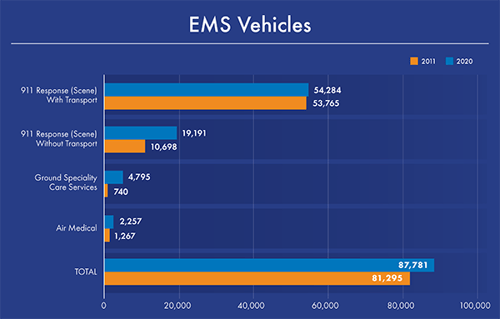
EMS Professionals and Medical Directors
EMS Professionals and Medical Directors are more difficult to compare “apples to apples” between the 2011 and 2020 due to changes in EMS curriculum and definitions. For this analysis, The 2011 First Responder maps closely to the 2020 Emergency Medical Responder (EMS) level. The 2011 Emergency Medical Technician (EMT) was compared to the 2020 Emergency Medical Technician, although there are differences. The 2011 EMT Intermediate level provider compares to the 2020 Advanced EMT level provider.
Information on Emergency Medical Dispatch (EMD) level providers was not collected in 2011, therefore no comparisons can be made. EMD data from 2020, however, was included in the EMS Professional numbers. EMS Medical Director numbers are captured in the graph below, but not included in the overall EMS Professional total.
Overall, the total number of EMS Professionals increased from 826,111 in 2011 to 1,052,842 in 2020. This reflects a total growth of 27.5% or 2.8% average annual growth.
Noteworthy observations in comparing the 2011 with the new 2020 EMS Assessment include:
- Advanced EMT level providers decreased from 54,855 in 2011 to 39,294 in 2020. This represented a decrease of 28.9% or an average annual decrease of 2.9%.
- Paramedic level providers increased from 203,807 in 2011 to 268,420 in 2020. This represented an increase of 31.7% or an average annual increase of 3.2%.
- EMS Medical Director numbers increased from 8,459 in 2011 to 9,808 in 2020. This represented an increase of 16.0% or an average annual increase of 1.6%. It should be noted that much of the increase in EMS Medical Directors has occurred in the past few years, due to the approval of the EMS Medical Director Board Certification process.
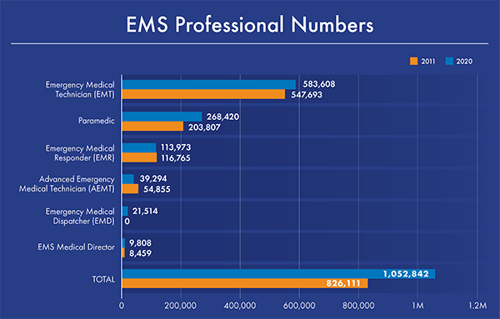
EMS Response and Patient Care
EMS Response and Transport Numbers are mapped to the NEMSIS definition.
Overall, the total number of EMS Responses increased from 36,698,670 in 2011 to 42,583,534 in 2020. This was a growth of 16.0% or an average annual growth of 1.6%.
The total number of EMS Transports increased from 28,004,624 in 2011 to 30,887,679 in 2020, showing total growth of 10.3% or 1.0% average annual growth.
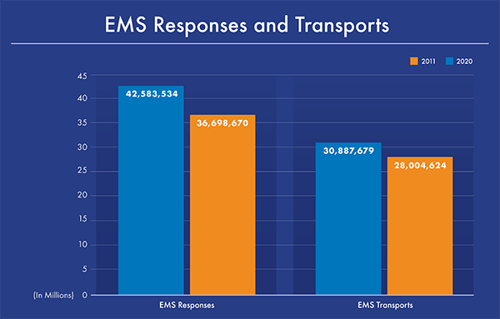
Summary
In closing, although these data have been collected using a voluntary survey of State EMS Directors and represents EMS from a state regulatory perspective, it is descriptive of the EMS industry. There are some interesting trends which have occurred during the past 10 years:
- The number of EMS Agencies Responding to the Scene With Transport decreased while the number of Specialty Ground Care and Air Medical Services increased.
- The number of EMS Vehicles increased by 8% (0.8%) annually but over 75% of that growth was with the Specialty Ground Care and Air Medical Services.
- EMS Vehicles Responding to the Scene With Transport only grew 1.0% or an average of 0.1% per year over the 10 years.
- Overall the total number of EMS Professionals increased 27.5% or an average annual growth of 2.8% over the 10 years. Due to educational and credentialing level changes, it is difficult to explore this more deeply.
- The number of EMS Medical Directors increased by 16% or an average growth of 1.6% over the 10 years. This is encouraging as there has been a shortage of EMS Medical Directors historically. Most of this growth is likely in the past few years and associated with EMS Board Certification.
Related Posts
How EMS Agencies Can Reframe Need and Refocus Resources With Geospatial Analytics
How To Minimize Radio Chatter and Reduce Guesswork With Smarter Dispatch Resource Management
ZOLL Pulse Blog
Subscribe to our blog and receive quality content that makes your job as an EMS & fire, hospital, or AR professional easier.
ZOLL Pulse Blog
Subscribe to our blog and receive quality content that makes your job as an EMS, fire, hospital, or AR professional easier.



